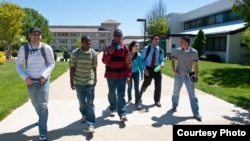From VOA Learning English, this is As It Is. I’m Anna Matteo in Washington.
A degree from a college or university is often the key that opens doors of opportunity -- doors to a better job and a better life. Without a college degree, many jobs are simply not available.
In the second half of our show, we will hear about a program that offers international students who may not have access to higher education a chance to reach their goals.
But first, we talk a little more about community colleges.
Just as the name states, community colleges are local. So, they are easy to get to. A person does not need to move to a different city to attend a community college program. And the cost of community colleges is much lower than tuition at four-year colleges and universities.
For those people not ready to commit to a four-year program, community college is a great place to start. If you have a full-time job, you can take classes at night. You can experiment with different subjects to figure out what you want to be when you grow up – to use a popular expression.
For me, community college was the road that led to a four-year university program, which then led to a scholarship to study in China.
For some facts and figures on community colleges, here is Bob Doughty.
The Community College Option
Suppose you are thinking about attending college in the United States. But perhaps you might not be ready for a university with a four-year program.
About 88,000 international students have found a solution. They are attending US community colleges. Such colleges are sometimes called junior colleges. They offer two years of education above the secondary, or high school level.
At the end of their study program, they receive a document of completion called a certificate. Other students work toward an associate degree in traditional academic subjects like science or history. Some students with associate degrees move on to attend a four-year college or university. They may have only two years of study left before they receive a bachelor’s degree.
Many educational experts agree that saving money is a good reason to consider a community college. The American Association of Community Colleges says a public two-year college costs an average of $3,000 a year.
A student at a four-year public college may pay more than $8,500 a year for classes and user fees.
International students may need more preparation in English before entering a four-year school in the United States. For example, Istref Montgomery came to the US from Kosovo in 2006. He soon will graduate from the University of Maryland’s University College.
But he did not begin his college-level education at the university. First, he spent three years at a Maryland junior college with -- by chance -- the same name as his last name. He worked to improve his English at Montgomery College for a year. Then, for the next two years, he attended classes in basic subjects.
Some international students at two-year colleges need to find a place to live. Most community colleges do not provide student housing on their grounds. But Mr. Montgomery had a home nearby.
I’m Bob Doughty.
And I’m Anna Matteo. You are listening to As It Is from VOA Learning English.
In the first part of the show, we talked about the value of community colleges in the U.S. Next, we will hear about the Community College Initiative Program. It is a program that targets international students who may not have many education choices.
Education reporter Jerilyn Watson has more.
Community College Initiative Program
Today we tell about a program at some American community colleges for students from several nations. It is called the Community College Initiative Program. It is for students from areas underserved in education and skills training.
Since 2007, about 2,100 students have taken part in the program. The Bureau of Educational Affairs of the U.S. State Department provides for their needs.
Three consortia, or organizations, of community colleges administer the program with the Bureau of Educational Affairs. Schools across the country take part.
Syedur Rahman is project director of the Community College Consortium led by Northern Virginia Community College. He says United States community colleges offer possibilities for foreign students whose governments cannot do so. He says many students in poor, rural areas do not have an equal cha nce to succeed.
“So there are many students, students who don’t have opportunities like those who are some of the major cities.
They’re underserved by the government in education, in health, you know, in services like opportunities for entrepreneurship.
So that is what’s meant by underserved…. One of the unique aspects of the U.S., and more so in terms of the Community College Initiative Program, is to reach out to those kids ((young people)) and to see if, given the opportunities, that they also will excel.”
At the start of their stay in America, students deepen their knowledge of English and learn about their schools’ surroundings. They have several fields of study to choose from including information technology, business administration the hotel and visitors industries, media and journalism, engineering and agriculture.
Students attend classes and study at school. But, they also are active in other school activities. They hold internships at businesses and nonprofit organizations.
Students also give presentations about their countries to other students and local communities. And they do many hours of community service.
You can get more information about the program from the Public Affairs Section of the United States Embassy in your country.
I’m Jerilyn Watson.
And I’m Anna Matteo. Tune in again tomorrow for another As It Is from VOA Learning English.
We are sorry, but this feature is currently not available









